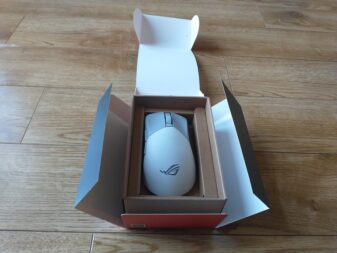 You’re looking for an upgrade to your gaming mouse, and ASUS has one for you to consider. The ROG Gladius III mouse promises improved performance and flexibility to meet your gaming needs. For my review, I paired it with the ROG Hone Ace Aim Lab Edition mouse pad. Could the mouse and mouse pad together improve your gaming skills? Here’s what I found.
You’re looking for an upgrade to your gaming mouse, and ASUS has one for you to consider. The ROG Gladius III mouse promises improved performance and flexibility to meet your gaming needs. For my review, I paired it with the ROG Hone Ace Aim Lab Edition mouse pad. Could the mouse and mouse pad together improve your gaming skills? Here’s what I found.
ASUS ROG Gladius III mouse physical features
All cardboard packaging
 First, I was happily surprised to see that the Gladius III had almost no plastic in its packaging. The ingenious cardboard box was sturdy but easy to open and unfold. After years of dealing with single-use plastic clamshells and superfluous plastic trays within the packaging itself, this box was a nice change of pace. I hope all the manufacturers adopt a similar approach.
First, I was happily surprised to see that the Gladius III had almost no plastic in its packaging. The ingenious cardboard box was sturdy but easy to open and unfold. After years of dealing with single-use plastic clamshells and superfluous plastic trays within the packaging itself, this box was a nice change of pace. I hope all the manufacturers adopt a similar approach.
Lightweight
I usually don’t pay much attention to the weight of a mouse, but then I picked this one up. Compared to my regular mouse, the Gladius III feels almost weightless. Its official weight is just under 90 grams, which is astounding for a mouse with an internal rechargeable battery. You’ll see the benefit of the light mouse during your hours of gaming, because less weight means less work for your wrist and arm.
Teflon feet
The feet of a mouse are the points where the bottom of the mouse contact the surface beneath it.The ROG Gladius III mouse has Teflon coated feet. Yes, that’s the same coating that makes your frying pan non-stick. By reducing the friction between the mouse feet and the mouse pad, the Teflon coating improves the speed of mouse movement. I didn’t think I would notice much of a difference because of this, but I did. When I compared the mouse’s motion to my regular mouse, I was amazed at how much faster and smoother it was.
Paracord cable
 This is another feature aimed at improving the smoothness and speed of mouse movement. The paracord is incredibly flexible, so it can move along with the mouse in whatever direction. And the texture of the cord is designed to lessen the snags that regular mouse cords are prone to. Since the wired connection is my preference, the cord’s improvements were a welcome surprise.
This is another feature aimed at improving the smoothness and speed of mouse movement. The paracord is incredibly flexible, so it can move along with the mouse in whatever direction. And the texture of the cord is designed to lessen the snags that regular mouse cords are prone to. Since the wired connection is my preference, the cord’s improvements were a welcome surprise.
ASUS ROG Gladius III Mouse technical features
Connectivity
I like options when it comes to mouse connectivity. And that’s what the Gladius III offers. You can use a 2.4GHz wireless connection, Bluetooth, or a USB 2.0 cable. Since each connection method has its own advantages and challenges, the ability to change between them is helpful. My preference is the wired connection, due to the lack of possible interruption from other nearby devices.
ROG Gladius III mouse optical sensor
Your mouse’s performance depends on the optical sensor: how quickly can it register the mouse’s movement. This is measured in the dots per linear inch, or DPI of the mouse. The higher the DPI is, the more sensitive the mouse is. The Gladius III mouse optical sensor has a base 19,000 DPI that has been tuned to reach a modified maximum of 26,000. In practical terms, that’s incredibly sensitive. I’m not skilled enough as a gamer to handle the maximum DPI, so I set it much lower than that. But with practice, I could really see a benefit in that level of sensitivity.
Polling rate
This is the measurement of how often the mouse will update your computer. A high polling rate means less variance of response time between your mouse’s movement and the cursor’s position change on the monitor. The Gladius III mouse’s high polling rate of 1000Hz (once every millisecond) means predictable and reliable response times.
ROG micro switches
The micro-switch is the component that registers when the left and right mouse buttons are pressed. The Gladius III mouse microswitches have a lifespan of 70 million clicks, which is long enough that only the most competitive player, or aggressive over-clicker, will need to replace them. You also have the option, thanks to the Push-Fit Switch Socket II, to hot swap the ROG mechanical switches with optical switches. I’m happy to stick with the mechanical switches, personally, but having options is always nice.
Gladius III mouse buttons
The Gladius III mouse has six programmable buttons plus a scroll wheel. And, it has a profile button that allows you to quickly change the settings in use. You can save five different memory profiles, though the saved settings cannot include macros or Windows shortcuts. I was able to change the button mappings easily, and use the profile button to change between profiles instantly.
Another feature of the Gladius III buttons is that they are pivoted. That means there is no gap between the button and the switch, reducing the time between button press and switch activation. And the mouse’s firmware filters out unintentional mouse clicks, so you’re less likely to accidentally drop a grenade at your own feet. Not that I’ve ever done that, of course.
RGB logo with Aura Sync
The logo and the scroll wheel of the Gladius III has an LED light that can be customized to match your existing lighting aesthetic. The lights are ASUS Aura compatible, which means you can synchronize them with your other Aura-compatible devices. As always, the most difficult part of setting up the lights on a device is deciding on a colour theme. One drawback is that using the RGB lighting while connected wirelessly will reduce the battery life. So if the visual appeal of the lights is important to you, use the wired connection.
ASUS Armory Crate
This is the software designed by ASUS to customize the settings and configurations of all your ASUS devices like the ROG Gladius III mouse. I had no issues with Armory Crate, and it let me easily adjust the settings of the Gladius III. And with the Aura feature, any change you make in the colour display will be automatically applied across your various Aura-compatible devices. Not having to make the same colour adjustment to each device separately is a real time-saver.
ROG Hone Ace Aim Lab Edition mouse pad
As a part of the review of the Gladius III, I paired it with another new product from ASUS, the ROG Hone Ace Aim Lab mouse pad. It’s a larger mouse pad, 50cm x 42cm, so you’ll have more room to move the mouse. And it may be the only mouse pad with affiliated software. The Aim Lab software is a training app to improve your mouse accuracy. You use it in conjunction with the measurement markings on the mouse pad itself, to train your eye and hand movement for better accuracy. The cloth surface of the mouse pad strikes a good balance between smoothness and necessary friction. And the ROG Hone Ace Aim Lab mouse pad has a nano-coating that is water-, dust-, and oil-repellent. As a less than tidy gamer, I appreciate that.
Final thoughts
The ROG Gladius III mouse delivers on its promise of high performance and customizability. When you combine it with an effective mouse pad like the ROG Hone Ace Aim Lab mouse pad, you get the right combination of low friction movement and tactile feedback. The ability to train your aim is helpful for any aspiring E-sports competitor and is a welcome feature. I loved the lightweight and feel of the mouse. The three different connectivity options also made it easy to get the best connection for every situation, be it intensive gaming or general productivity. I recommend the ROG Gladius III mouse for both the casual PC gamer and for anyone thinking of taking their gaming to the next level of competition.




I agree with you that the Teflon coating on the ROG Gladius III mouse makes a big difference in the speed and smoothness of the mouse’s movement. I was also surprised at how much of a difference it made when I compared it to my regular mouse.
Comments are closed.